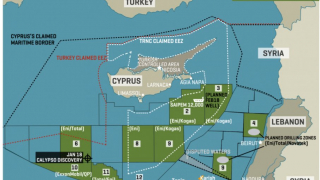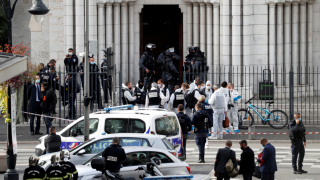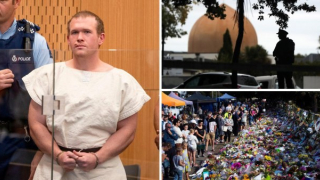Political Extremism in the Technocratic Order
“Extremists have taken over and they’re the ones who run the foreign policy and have convinced us to go along with all these wars.”—Congressman Ron Paul[1]
The alleged bogey of “extremism” has become a prominent element of public discourse particularly since the mid-1990s. The assumed terroristic tendencies of ordinary Americans is a preoccupation of many mainstream and liberal intellectuals apparently more concerned with moral guardianship than the growing police state and continued wartime economy. These conditions underline a campaign to promote paranoia that only intensified following September 11, 2001. As the specter of deviant commoners helps validate accelerated repressive measures, the state’s genuine extremism of illegal wars and evisceration of most civil liberties falls from public purview.
 The 1995 bombing of the Oklahoma City Murrah Federal Building set the stage for the creation of an imaginary extremist other—“bitter clingers” in today’s parlance–purportedly emerging from a noxious combination of Bible study, country music, and gun collecting. Against this and similar “extreme” archetypes a normality is defined where the broader population is encouraged to confirm a tentative political identity and rationalize the support of intensified social control measures.
The 1995 bombing of the Oklahoma City Murrah Federal Building set the stage for the creation of an imaginary extremist other—“bitter clingers” in today’s parlance–purportedly emerging from a noxious combination of Bible study, country music, and gun collecting. Against this and similar “extreme” archetypes a normality is defined where the broader population is encouraged to confirm a tentative political identity and rationalize the support of intensified social control measures.
The often strange and misunderstood instances of probable state-sponsored terror—of which the Oklahoma City incident is the most well known and incontestable —alongside the prominence of well funded establishment-oriented quasi-intelligence and disinformation outlets such as the Southern Poverty Law Center and the Anti-Defamation League misleadingly conflate political thought, extremism and terror together in the public mind with dangerous implications for meaningful open debate and the preservation of important civil liberties.
In the months leading up to the Oklahoma City bombing Senator Joe Biden and subsequently the Clinton Administration laid the legislative groundwork for the 2001 PATRIOT Act that criminalized political thought and undermined the Posse Comitatus Act.[2] September 11, 2001 merely provide the pretext for the law’s ratification. Subsequent decrees including the 2011 National Defense Authorization Act further established such measures by giving the president the power to kill or imprison US citizens for suspected terrorism.
With this in mind the creation of a political other serves two closely related purposes. First, it provides the basis for a mechanism through which such draconian measures outlawing “extremist” ideas and activity may be put into practice.
Second, the relentless political balkanization of the public psyche and the reinforcement of this process through the creation of an extremist other deflects attention away from those in public office and, more importantly, the global power brokers who pull their strings.
The overall result is that while public attention is riveted toward would be extremist bogeys, genuinely verifiable and truly dangerous extremism of socio-economic and political elites proceeds apace with little notice. Those exerting control from above through technocratic means maintain their sovereignty by dividing the population, as the British colonialists did in India, Ireland and the Middle East. “The desires of the people were manipulated and turned against each other,” author and psychiatrist Joel Kovel observes,
so that in many cases the rulers were able to appear as philosopher-kings, high above the violent and unruly passions of their subjects. A similar mechanism applied to the manipulation of racial divisions among the working class in the U.S. Racist violence then seemed to belong to the dispossessed rabble, such as the Ku Klux Klan, while the liberal-technocratic state presented itself as having a monopoly on justice and rationality.[3]
Nowhere is this liberal technocratic rationality more on display than in the academy where police state policies are imparted the veneer of disinterested inquiry and foresight.
Nebulous Extremism and “Crippled Epistemologies”
In the era of endless war the US Department of Justice’s (DOJ) own literature makes no distinction between “extremism” and “terrorism.” The volume, Investigating Terrorism and Criminal Extremism: Terms and Concepts, for example, collapses the ideas and terminology of Al Qaeda, environmental activism, the patriot-Constitutional movement, and neo-Nazism together “for criminal justice professionals to effectively combat terrorism/extremism.”[4]
Along these lines overt rhetorical efforts are made to connect political thought with violent behavior. In August 2011 the Obama Administration issued a directive, ”Empowering Local Partners to Prevent Violent Extremism in the United States.” The policy instructs authorities in local communities and even families to take countermeasures “radicalization that leads to violent extremism.”
“This strategy commits the Federal Government to improving support to communities,” President Obama asserts in the document’s preamble, “including sharing more information about the threat of radicalization; strengthening cooperation with local law enforcement … and helping communities to better understand and protect themselves against violent extremist propaganda, especially online.”[5]
The fruits of authoritarianism never fall too far from the given society’s knowledge-producing tree. In this regard Cass Sunstein, the well known Harvard law professor and former chief administrator of Obama’s Office of Information and Regulatory Affairs, figures prominently in the creation of the extremist bogey. Sunstein’s 2009 treatise Going To Extremes: How Like Minds Unite and Divide codifies a set of principles that would be very much at home in Plato’s Republic. While the scholar’s ideas have been sufficiently panned elsewhere,[6] they are important contributing elements to the domestic extremist archetype and thus revisited here.
For Sunstein, a significant portion of the public is simply not capable of exercising the critical thought necessary to discern between fact and fantasy. Many individuals are thus susceptible to taking on the wrongheaded beliefs of cult leaders and demagogues who manage to physically or psychologically isolate unsuspecting converts and subject them to a strict regime of information control. This results in “group polarization” that could lead to extremism (a key term Sunstein never defines, to which I return below).
Akin to Obama’s 2011 policy announcement, an underlying motif steadily links popular activist causes with aberrant thinking and potentially “extremist” activity. For example,
If you hear that genetically modified foods pose serious risks, and if that view is widespread in your community, you might end up frightened. If you hear nothing about the risks associated with genetically modified food, except perhaps that some zealots are frightened, you will probably ridicule their fear. And when groups move in dangerous directions—toward killing and destruction—it is usually because the flow of information supports that movement.[7]
While Sunstein characteristically champions the intrinsic relationship between democracy and a free marketplace of ideas throughout, his argument rests on the elitist assertion that those potential “extremists” are mentally incapable of partaking in investigation and independent thought.
In such a Jonestown-style milieu, where unwilling subjects blithely advance toward the brink of extremism, they tend even more toward unsound information and opinion that confirms their already warped worldviews. Such individuals “suffer from a ‘crippled epistemology’,” Sunstein concludes, “in the sense that they know very few things and what they know is wrong.”
In instances of such willful informational deprivation “conspiracy theories” tend to gain a foothold, as such individuals are easy prey for “conspiracy entrepreneurs” who author popular tracts extending unsettling observations about 9/11, the origins of AIDS, and the Kennedy assassinations.[8]
Yet the path to extremism is not as easily traveled by anti-GMO advocates in California or 9/11 Truth activists in New York as it is by Al Qaeda forces in the Middle East. “In a democracy … the existence of ample information, with some kind of marketplace of ideas, is more likely to defang terrorists,” Sunstein asserts, “simply because their accounts can be shown to be implausible.”[9]
Sunstein’s own ideas on how such a “democratic” marketplace of ideas should take shape cannot stand the light of day. If scathing condemnation of his thoughts and proposals across the internet were not enough, in May 2012 the 9/11 truth activist and journalist Luke Rudkowski asked the law professor about his 2009 paper, “Conspiracy Theories: Causes and Cures,” advocating COINTELPRO-style subversion of research communities rejecting the US government’s claims concerning the 9/11 attacks.[10] Sunstein’s disavowal of the piece and Nixonesque departure suggests a great deal about his own integrity and designs for short-circuiting the public sphere.
Nevertheless, sharing the mindset of imperial enterprise and maneuver, Sunstein’s argument and broader project fit alongside those of Gustav Le Bon, George Santayana, Walter Lippmann, and Edward Bernays, all of whom speak to a traditional elite concern over the threat of the masses. Sunstein and the US government take this once step further by erroneously linking objectionable thought (i.e. observations that are often true and verifiable) with criminal action.
Extremism of the Elite
The term “extremism” is routinely used for rhetorical effect without any explanation as to its true meaning. Since this is something Sunstein and like-minded thought police curiously spend little time on it is especially deserving of consideration.
When the term extremism is invoked by agencies of the federal government or their intellectual foot soldiers it is meant to signify the violation of a norm, belief, or practice deemed reasonable by those with inordinate power to influence public opinion. Yet a more universally applicable definition might conclude that extremism denotes actions that deprive an individual of the freedom to partake in and derive joy from life, health, free association with others, and private property.
Under such a definition, and in contrast to genuine extremism, the extremism the technocratic state underscores is almost entirely mobilized to instantiate and confirm the corporatized politics of imagined opinion.[11] Such nuanced propaganda directed at law enforcement and the general public alike polarizes the psyche much more so than the efforts of demagogues or isolated political groups.
Indeed, the obsession with “extremism” is an especially curious and unusual diversion when one considers how most Islamic fundamentalism associated with terror groups is the product of Western intelligence-backed political parties or movements.[12] Further, virtually every terrorist event in the US since September 11, 2001 has involved the US government’s cultivation and entrapment of dupes and fall guys.[13]
Genuine extremism is practiced by individuals and institutions that evade scrutiny while the false political bogeys they create take center stage. Those who devote their intellectual energies to serving the police state by designing select notions of “extremism” vis-à-vis acceptable modes of thought have made a substantial contribution to this longstanding wall of mirrors. All the while the true extremists proceed with their self-designed “war on terror”—what is in fact a war on the pursuit of truth and the continued possibility of civic life.
Notes
[1] Ginger Gibson, “Ron Paul: Glee in Administration After 9/11,” Politico.com, December 8, 2011.
[2] “Joe Biden Drafted the Core of the Patriot Act … Before the Oklahoma City Bombing,” Washingtons Blog, December 10, 2011.
[3] Joel Kovel, Against the State of Nuclear Terror, Boston: South End Press, 1983, 129.
[4] Bureau of Justice Assistance/US Department of Justice, Investigating Terrorism and Criminal Extremism: Terms and Concepts, Tallahassee FL: Institute for Intergovernmental Research, 2005-2009, 3. Available at http://publicintelligence.net/doj-terrorism-and-criminal-extremism-terms-and-concepts-guide/
[5] “Empowering Local Partners to Prevent Violent Extremism in the United States,” August 3, 2011, 6, n.p. Available at http://publicintelligence.net/white-house-strategy-for-countering-violent-extremism-in-the-united-states/
[6] For example, David Ray Griffin, Cognitive Infiltration: An Obama Appointee’s Plan to Undermine the 9/11 Conspiracy Theory, Northampton MA: Olive Branch Press, 2011.
[7] Cass R. Sunstein, Going to Extremes: How Like Minds Unite and Divide, New York: Oxford University Press, 2009, 23.
[8] Sunstein, 109-111.
[9] Sunstein, 116.
[10] We Are Change, “Obama Information Czar Cass Sunstein Confronted on Cognitive Infiltration,” Youtube, May 1, 2012, https://www.youtube.com/watch?v=4OIiOztc52g
[11] James Tracy, “The Politics of Imagined Opinion,” Global Research, March 10, 2012.
[12] Michel Chossudovsky, America’s “War on Terrorism”, Ottawa: Centre for Research on Globalization, 2005.
[13] “FBI Agents Responsible for Majority of Terrorist Plots in the United States,” Project Censored, October 10, 2012.
Source: Global Research











